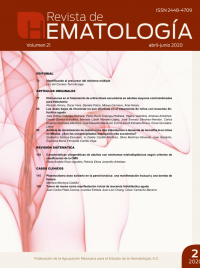Low doses of rituximab are not effective in the treatment of children with acute lymphocytic leukemia.
Rev Hematol Mex. 2020 abril-junio;21(2):86-91. https://doi.org/10.24245/rev_hematol.v21i2.3722
Julia Esther Colunga-Pedraza, Perla Rocío Colunga-Pedraza, Yajaira Valentine Jiménez-Antolinez, Daniel Gómez-González, Marcela Lizeth Morales-López, José Ernesto Sánchez-Rendón, Carlos Eugenio González-Martínez, José Eduardo Mares-Gil, Emma Lizeth Estrada-Rivera, Óscar González-Llano
Servicio de Hematología, Facultad de Medicina y Hospital Universitario Dr. José Eleuterio González, Universidad Autónoma de Nuevo León, Monterrey, Nuevo León, México.
Resumen
ANTECEDENTES: El rituximab, anticuerpo monoclonal (AcM) dirigido contra el antígeno CD20 de los linfocitos B, provoca disminución de linfocitos normales y malignos.
OBJETIVO: Evaluar la efectividad de rituximab al incorporarlo a dosis reducidas en el esquema de tratamiento de niños con leucemia linfoblástica aguda de células B CD20+.
MATERIAL Y MÉTODO: Estudio piloto, experimental, sin distribución al azar, no ciego, de un brazo, realizado de septiembre de 2016 a marzo de 2018. Se agregaron al tratamiento de quimioterapia cuatro dosis de rituximab de 100 mg/m2 de superficie corporal. Se comparó con un grupo control histórico y se evaluó la remisión completa, la supervivencia global y libre de eventos.
RESULTADOS: Se incluyeron 14 pacientes en el esquema de dosis bajas de rituximab y 33 en el control histórico. Se valoró la remisión completa por enfermedad mínima residual (EMR), 4 pacientes (30%) tuvieron EMR+ y 11 (70%) EMR– posinducción, ninguno persistió con EMR+ posconsolidación. En el control histórico encontramos 6 pacientes (20%) con EMR+ y 24 (80%) EMR- posinducción, 4 (13%) persistieron con EMR+. Las tasas de remisión completa posinducción fueron similares en ambos grupos, se observó tendencia de mejores tasas de remisión completa posconsolidación en el grupo con dosis bajas de rituximab sin diferencias estadísticamente significativas. La supervivencia global y libre de eventos a 2 años fue de 61.9 y 61.9% versus 72.5 y 69.1%, respectivamente, sin significación estadística.
CONCLUSIÓN: La administración de dosis reducidas de rituximab no mejoró las tasas de remisión completa, supervivencia global y libre de eventos.
PALABRAS CLAVE: Rituximab; leucemia linfoblástica aguda; pediatría.
Abstract
BACKGROUND: Rituximab is a chimeric monoclonal antibody (cAb) directed against the CD20 antigen of B lymphocytes that causes a decrease in normal and malignant lymphocytes.
OBJECTIVE: To evaluate the effectiveness of incorporating reduced doses of rituximab in the treatment scheme of children with B-cell acute lymphoblastic leukemia (ALL) CD20+.
MATERIAL AND METHOD: A pilot, experimental, non-randomized, non-blind, single-arm trial was done from September 2016 to March 2018, in which a total of 4 doses of rituximab at 100mg/m2 was incorporated into the chemotherapy treatment scheme. It was compared with a historical control group, and we evaluated the complete response (CR), global survival (GS) and events-free survival (EFS).
RESULTS: Fourteen patients were included in the low dose scheme of rituximab and 33 patients in the historical control. CR to the treatment for minimal residual disease (MRD) was assessed, 4 patients (30%) presented MRD+ and 11 (70%) MRD– post-induction, no patient persisted with MRD+ post-consolidation. While in the historical control we found 6 patients (20%) with MRD+ and 24 (80%) MRD– post-induction, 4 patients (13%) persisted with MRD+. The rates of CR post-induction were similar in both groups; a trend was observed of better rates of CR post-consolidation in the group with low doses of rituximab with no statistically significant differences. The GS and EFS at 2 years were 61.9% and 61.9% versus 72.5% and 69.1%, respectively with no statistical significance.
CONCLUSION: The use of reduced doses of rituximab didn’t improve the rates of GS, EFS and CR.
KEYWORDS: Rituximab; Acute lymphoblastic leukemia; Pediatrics.

